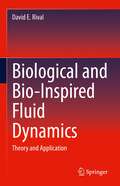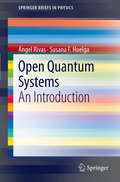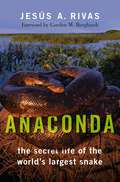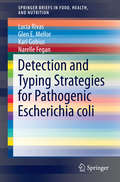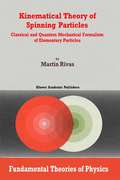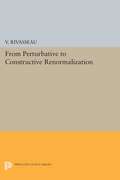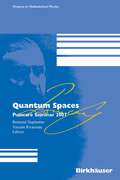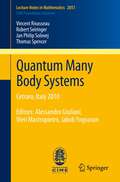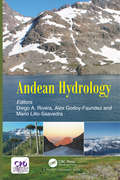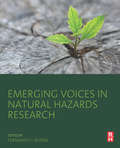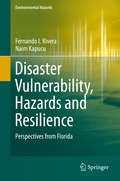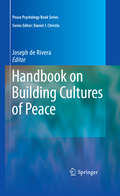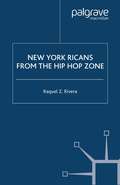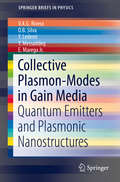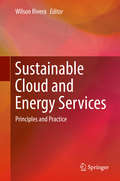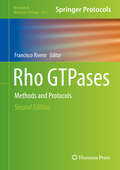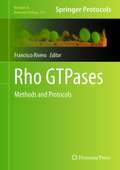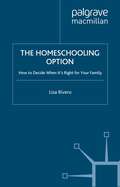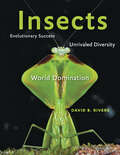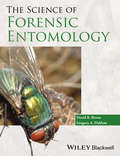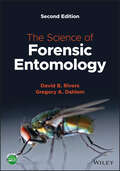- Table View
- List View
Biological and Bio-Inspired Fluid Dynamics: Theory and Application
by David E. RivalThis text provides the reader with tools necessary to study biological and bio-inspired flows, all the while developing an appreciation for their evolutionary and engineering constraints. It is suitable for students already exposed to introductory concepts in fluid mechanics and applied mechanics as a whole, but who would not need an advanced training in fluid mechanics per se. Currently no textbook exists that can take students from an introductory position in fluid mechanics to these contemporary topics of interest. The book is ideal for upper-level undergraduates and graduate students studying a range of engineering domains as well as biology, or even medicine.
Open Quantum Systems: An Introduction (SpringerBriefs in Physics)
by Ángel Rivas Susana F. HuelgaIn this volume the fundamental theory of open quantum systems is revised in the light of modern developments in the field. A unified approach to the quantum evolution of open systems is presented by merging concepts and methods traditionally employed by different communities, such as quantum optics, condensed matter, chemical physics and mathematical physics. The mathematical structure and the general properties of the dynamical maps underlying open system dynamics are explained in detail. The microscopic derivation of dynamical equations, including both Markovian and non-Markovian evolutions, is also discussed. Because of the step-by-step explanations, this work is a useful reference to novices in this field. However, experienced researches can also benefit from the presentation of recent results.
Anaconda: The Secret Life of the World's Largest Snake
by Jesús A. RivasAnaconda tells the unexpected story of the world's largest snake. Written by Jesús Rivas, the undisputed expert on the biology of anacondas, this is the first authoritative book on the biology of the green anaconda. In this book, Rivas describes his experiences over a quarter of a century, exploring the secret life of these fantastic snakes, including: their diet, movement patterns, life and tribulations, survival, behavior, and fascinating reproductive life. More than just presenting facts about anacondas, Rivas tells his story about studying them in the field. Anaconda presents a comprehensive treatment of the natural history of the elusive green anacondas. Drawing on twenty-five years of research on this reptile in the wild and in captivity, Rivas delves into the biology, behavior, demography, reproductive habits, and diet of the anaconda, as well as issues relating to its conservation. Rivas uses an ecological and evolutionary framework to present his research and supplements hard data with descriptions of his research methods, including how he tracked down the anaconda for observation and study in wild. The resulting book is a complete and engaging examination of the world's largest snake. The rich photographs provided, paired with Rivas' storytelling, makes this the perfect book for anyone looking to learn (or even learn more!) about this mysterious snake.
Anaconda: The Secret Life of the World's Largest Snake
by Jesús A. RivasAnaconda tells the unexpected story of the world's largest snake. Written by Jesús Rivas, the undisputed expert on the biology of anacondas, this is the first authoritative book on the biology of the green anaconda. In this book, Rivas describes his experiences over a quarter of a century, exploring the secret life of these fantastic snakes, including: their diet, movement patterns, life and tribulations, survival, behavior, and fascinating reproductive life. More than just presenting facts about anacondas, Rivas tells his story about studying them in the field. Anaconda presents a comprehensive treatment of the natural history of the elusive green anacondas. Drawing on twenty-five years of research on this reptile in the wild and in captivity, Rivas delves into the biology, behavior, demography, reproductive habits, and diet of the anaconda, as well as issues relating to its conservation. Rivas uses an ecological and evolutionary framework to present his research and supplements hard data with descriptions of his research methods, including how he tracked down the anaconda for observation and study in wild. The resulting book is a complete and engaging examination of the world's largest snake. The rich photographs provided, paired with Rivas' storytelling, makes this the perfect book for anyone looking to learn (or even learn more!) about this mysterious snake.
Detection and Typing Strategies for Pathogenic Escherichia coli (SpringerBriefs in Food, Health, and Nutrition #1)
by Lucia Rivas Glen E. Mellor Kari Gobius Narelle FeganThis Brief will review the methods that are currently available for the detection, isolation, and typing of pathogenic E. coli with a particular focus on foodborne diseases caused by the Shiga toxigenic E. coli group, which have been implicated in a number of significant outbreaks in recent years. Pathogenic forms of E. coli can cause a variety of diarrheal diseases in hosts due to the presence of specific colonization and virulence factors, and pathogenicity-associated genes, which are generally not present in other E. coli. Six pathotypes of pathogenic E. coli are recognized (Shiga toxigenic E. coli, Enteropathogenic E. coli, Enterotoxigenic E. coli, Enteroinvasive E. coli, Enteroaggregative E. coli and Diffusely Adherent E. coli) and certain strains among these groups are major public health concerns due to the severity of disease that they can cause. Methods to detect and isolate these pathogens from a variety of sources are constantly evolving. In addition, the accumulation of knowledge on these pathogens allows for improved intervention strategies.
Kinematical Theory of Spinning Particles: Classical and Quantum Mechanical Formalism of Elementary Particles (Fundamental Theories of Physics #116)
by M. RivasClassical spin is described in terms of velocities and acceleration so that knowledge of advanced mathematics is not required. Written in the three-dimensional notation of vector calculus, it can be followed by undergraduate physics students, although some notions of Lagrangian dynamics and group theory are required. It is intended as a general course at a postgraduate level for all-purpose physicists. This book presents a unified approach to classical and quantum mechanics of spinning particles, with symmetry principles as the starting point. A classical concept of an elementary particle is presented. The variational statements to deal with spinning particles are revisited. It is shown that, by explicitly constructing different models, symmetry principles are sufficient for the description of either classical or quantum-mechanical elementary particles. Several spin effects are analyzed.
From Perturbative to Constructive Renormalization
by V. RivasseauThe last decade has seen striking progress in the subject of renormalization in quantum field theory. The old subject of perturbative renormalization has been revived by the use of powerful methods such as multiscale decompositions; precise estimates have been added to the initial theorems on finiteness of renormalized perturbation theory, with new results on its large order asymptotics. Furthermore, constructive field theory has reached one of its major goals, the mathematically rigorous construction of some renormalizable quantum field theories. For these models one can in particular investigate rigorously the phenomenon of asymptotic freedom, which plays a key role in our current understanding of the interaction among elementary particles. However, until this book, there has been no pedagogical synthesis of these new developments. Vincent Rivasseau, who has been actively involved in them, now describes them for a wider audience. There are, in fact, common concepts at the heart of the progress on perturbative and constructive techniques. Exploiting these similarities, the author uses perturbative renormalization, which is the more widely known and conceptually simpler of the two cases, to explain the less familiar but more mathematically meaningful constructive renormalization.Originally published in 1991.The Princeton Legacy Library uses the latest print-on-demand technology to again make available previously out-of-print books from the distinguished backlist of Princeton University Press. These editions preserve the original texts of these important books while presenting them in durable paperback and hardcover editions. The goal of the Princeton Legacy Library is to vastly increase access to the rich scholarly heritage found in the thousands of books published by Princeton University Press since its founding in 1905.
Quantum Spaces: Poincaré Seminar 2007 (Progress in Mathematical Physics #53)
by Vincent RivasseauThis book confirms noncommutative geometry as an increasingly useful tool for the description of intricate condensed matter phenomena. It describes the striking progress recently made in gathering all the interactions and fields of the standard model into a non-commutative geometry on a simple internal space. Coverage also details the very recent technique of renormalization of quantum field theories on non-commutative space-time.
Quantum Many Body Systems: Cetraro, Italy 2010, Editors: Alessandro Giuliani, Vieri Mastropietro, Jakob Yngvason (Lecture Notes in Mathematics #2051)
by Vincent Rivasseau Robert Seiringer Jan Philip Solovej Thomas SpencerThe book is based on the lectures given at the CIME school "Quantum many body systems" held in the summer of 2010. It provides a tutorial introduction to recent advances in the mathematics of interacting systems, written by four leading experts in the field: V. Rivasseau illustrates the applications of constructive Quantum Field Theory to 2D interacting electrons and their relation to quantum gravity; R. Seiringer describes a proof of Bose-Einstein condensation in the Gross-Pitaevski limit and explains the effects of rotating traps and the emergence of lattices of quantized vortices; J.-P. Solovej gives an introduction to the theory of quantum Coulomb systems and to the functional analytic methods used to prove their thermodynamic stability; finally, T. Spencer explains the supersymmetric approach to Anderson localization and its relation to the theory of random matrices. All the lectures are characterized by their mathematical rigor combined with physical insights.
Andean Hydrology
by Diego A. Rivera Alex Godoy-Faundez Mario Lillo-SaavedraThis book describes the ecosystem of the Andean watersheds, covering the Californian valley, tropical Andes, and southern Andes. Case studies of the new methods and techniques used for hydrological research in the Andes are provided, and sustainability issues pertaining to Andean water resources are discussed in the context of climate change, social and economic issues, and public policy. Furthermore, the impact of economic development on the Andean ecosystem, specifically the effect on the water cycle and the water-energy-food nexus, are examined.
Andean Hydrology
by Diego A. Rivera Alex Godoy-Faundez Mario Lillo SaavedraThis book describes the ecosystem of the Andean watersheds, covering the Californian valley, tropical Andes, and southern Andes. Case studies of the new methods and techniques used for hydrological research in the Andes are provided, and sustainability issues pertaining to Andean water resources are discussed in the context of climate change, social and economic issues, and public policy. Furthermore, the impact of economic development on the Andean ecosystem, specifically the effect on the water cycle and the water-energy-food nexus, are examined.
Emerging Voices in Natural Hazards Research
by Fernando I. RiveraEmerging Voices in Natural Hazards Research provides a synthesis of the most pressing issues in natural hazards research by new professionals. The book begins with an overview of emerging research on natural hazards, such as hurricanes, earthquakes, floods, wildfires, sea-level rise, global warming, climate change, and tornadoes, among others. Remaining sections include topics such as socially vulnerable populations and the cycles of emergency management. Emerging Voices in Natural Hazards Research is intended to serve as a consolidated resource for academics, students, and researchers to learn about the most pressing issues in natural hazard research today.Provides a platform for readers to keep up-to-date with the interdisciplinary research that new professionals are producingCovers the multidisciplinary perspectives of the hazards and disasters fieldIncludes international perspectives from new professionals around the world, including developing countries
Disaster Vulnerability, Hazards and Resilience: Perspectives from Florida (Environmental Hazards)
by Fernando I. Rivera Naim KapucuThis monograph provides valuable lessons in building disaster resilience for rural communities and beyond. With a focus on Florida, the authors present a comprehensive review of the current debates surrounding the study of resilience, from federal frameworks, state plans and local initiatives. They also review evaluation tools and feature first-hand accounts of county emergency managers as well as non-profit and community groups on key issues, including perspectives on vulnerable groups such as the elderly, children and farm workers.Readers will find insightful answers to such questions as: How can the concept of resilience be used as a framework to investigate the conditions that lead to stronger, more sustainable communities? What factors account for the variation across jurisdictions and geographic units in the ability to respond to and recover from a disaster? How does the recovery process impact the social, political and economic institutions of the stricken communities? How do communities, especially rural ones, collaborate with multiple stakeholders (local, regional, state, national) during the transition from recovery to resilience? Can the collaborative nature of disaster recovery help build resilient communities?.The primary audiences of this book are scholars in emergency and crisis management, planning and policy, disaster response and recovery, disaster sociology and environmental management and policy. This book can also be used as a textbook in graduate and advanced undergraduate programs / courses on disaster management, disaster studies, emergency and crisis management, environmental policy and management and public policy and administration.
Handbook on Building Cultures of Peace (Peace Psychology Book Series)
by Joseph De RiveraMediation and negotiation, personal transformation, non-violent struggle in the community and the world: these behaviors – and their underlying values – underpin the United Nations’ definition of a culture of peace, and are crucial to the creation of such a culture. The Handbook on Building Cultures of Peace addresses this complex and daunting task by presenting an accessible blueprint for this development. Its perspectives are international and interdisciplinary, involving the developing as well as the developed world, with illustrations of states and citizens using peace-based values to create progress on the individual, community, national, and global levels. The result is both realistic and visionary, a prescription for a secure future.
New York Ricans from the Hip Hop Zone (New Directions in Latino American Cultures)
by R. RiveraNew York Puerto Ricans have been an integral part of hip hop culture since day one: from 1970s pioneers like Rock Steady Crew's Jo-Jo, to recent rap mega-stars Big Punisher (R.I.P.) and Angie Martinez. Yet, Puerto Rican participation and contributions to hip hop have often been downplayed and even completely ignored. And when their presence has been acknowledged, it has frequently been misinterpreted as a defection from Puerto Rican culture and identity, into the African American camp. But nothing could be further from the truth. Through hip hop, Puerto Ricans have simply stretched the boundaries of Puerto Ricanness and latinidad.
Collective Plasmon-Modes in Gain Media: Quantum Emitters and Plasmonic Nanostructures (SpringerBriefs in Physics)
by V.A.G. Rivera O.B. Silva Y. Ledemi Y. Messaddeq E. Marega Jr.This book represents the first detailed description, including both theoretical aspects and experimental methods, of the interaction of rare-earth ions with surface plasmon polariton from the point of view of collective plasmon-photon interactions via resonance modes (metal nanoparticles or nanostructure arrays) with quantum emitters (rare-earth ions). These interactions are of particular interest for applications to optical telecommunications, optical displays, and laser solid state technologies. Thus, our main goal is to give a more precise overview of the rapidly emerging field of nanophotonics by means of the study of the quantum properties of light interaction with matter at the nanoscale. In this way, collective plasmon-modes in a gain medium result from the interaction/coupling between a quantum emitter (created by rare-earth ions) with a metallic surface, inducing different effects such as the polarization of the metal electrons (so-called surface plasmon polariton - SPP), a field enhancement sustained by resonance coupling, or transfer of energy due to non-resonant coupling between the metallic nanostructure and the optically active surrounding medium. These effects counteract the absorption losses in the metal to enhance luminescence properties or even to control the polarization and phase of quantum emitters. The engineering of plasmons/SPP in gain media constitutes a new field in nanophotonics science with a tremendous technological potential in integrated optics/photonics at the nanoscale based on the control of quantum effects. This book will be an essential tool for scientists, engineers, and graduate and undergraduate students interested not only in a new frontier of fundamental physics, but also in the realization of nanophotonic devices for optical telecommunication.
Sustainable Cloud and Energy Services: Principles and Practice
by Wilson RiveraThis is the first book entirely devoted to providing a perspective on the state-of-the-art of cloud computing and energy services and the impact on designing sustainable systems. Cloud computing services provide an efficient approach for connecting infrastructures and can support sustainability in different ways. For example, the design of more efficient cloud services can contribute in reducing energy consumption and environmental impact. The chapters in this book address conceptual principles and illustrate the latest achievements and development updates concerning sustainable cloud and energy services. This book serves as a useful reference for advanced undergraduate students, graduate students and practitioners interested in the design, implementation and deployment of sustainable cloud based energy services. Professionals in the areas of power engineering, computer science, and environmental science and engineering will find value in the multidisciplinary approach to sustainable cloud and energy services presented in this book.
Rho GTPases: Methods and Protocols (Methods in Molecular Biology #1821)
by Francisco RiveroThis detailed book expands upon the previous edition with a collection of methods for those performing experimental work on small GTPases of the Rho family. Split into four sections, the volume explores computational modeling and imaging procedures, biochemical methods related to post-translational modifications of Rho GTPases as well as some high throughput methods, functional assays that allow for monitoring the consequences of manipulating Rho GTPases in a variety of cell types and cell biology processes, and techniques specifically designed for studies in selected non-mammalian model organisms (zebrafish, social ameba, plants and algae). Written for the highly successful Methods in Molecular Biology series, chapters include introductions to their respective topics, lists of the necessary materials and reagents, step-by-step, readily reproducible laboratory protocols, and tips on trouble shooting and avoiding known pitfalls. Authoritative and up-to-date, Rho GTPases: Methods and Protocols, Second Edition constitutes an invaluable tool for all those with an interest in this remarkable family of signaling proteins.
Rho GTPases: Methods and Protocols (Methods in Molecular Biology #827)
by Francisco RiveroAlthough initially described as major regulators of cytoskeletal remodeling, Rho GTPases have been implicated in the establishment of polarity, endocytosis, vesicle trafficking, morphogenesis, cytokinesis, transcriptional activation, cell cycle progression, and apoptosis, to mention a few. In addition, Rho GTPases have acquired medical relevance because of their participation in tumorigenesis and metastasis, in cardiovascular conditions, and as targets of infectious agents. The field has broadened even more with the contribution of studies in model organisms (plants, amoebas, fungi, invertebrates), each adding a particular view to the complexity of the family and vastly enriching our perception of these important signaling components. Divided into five convenient sections, Rho GTPase: Methods and Protocols provides an historical overview of the field and an account of the phylogenetics of the Rho family, general biochemical methods, and functional assays that allow monitoring the consequences of manipulating Rho GTPases in a variety of contexts. Additionally, the volume devotes a section to advanced imaging methods and to recently developed high throughput methods, closing with techniques specifically designed for studies in selected non-mammalian model organisms. Written in the successful Methods in Molecular Biology™ series format, chapters include introductions to their respective topics, lists of the necessary materials and reagents, step-by-step, readily reproducible protocols, and notes on troubleshooting and avoiding known pitfalls. Authoritative and easily accessible, Rho GTPase: Methods and Protocols provides techniques that are standard for researchers in the field but also includes protocols for those who, being already familiar with some of the techniques, wish to explore additional aspects.
The Homeschooling Option: How to Decide When It’s Right for Your Family
by L. RiveroCorrecting misconceptions through profiles of diverse families, Rivero uncovers the changing and complex needs of children today. This book addresses the major questions parents are bound to have as they consider the homeschooling option: socialization, curriculum, special needs arrangements, resources, and more.
Insects: Evolutionary Success, Unrivaled Diversity, and World Domination
by David B. RiversDesigned as an introduction to the intriguing world of insect biology, this book examines familiar entomological topics in nontraditional ways. Author David B. Rivers gives important concepts relatable context through a pop culture lens, and he covers subjects that are not typical for entomology textbooks, including the impact of insects on the human condition, the sex lives of insects, why insects are phat but not fat, forensic entomology, and the threats that some insects pose to humanity. Each chapter presents clear and concise key concepts, chapter reviews, review questions following Bloom’s taxonomy of learning, web links to videos and other resources, and breakout boxes (called Fly Spots) that capture student interest with unique and entertaining facts related to entomology. Focusing on both traditional and cutting-edge aspects of insect biology and packed with extensive learning resources, Insects covers a wide range of topics suitable for life science majors, as well as non-science students, including: • the positive and negative influences of insects on everyday human life• insect abundance• insect classification (here presented in the context of social media)• insect feeding, communication, defense, and sex• how insects are responding to climate change• forensic entomology• how insects can be used as weapons of war• how insects relate to national security• why insects have wings• how to read pesticide labels
The Science of Forensic Entomology
by David B. Rivers Gregory A. DahlemThe Science of Forensic Entomology builds a foundation of biological and entomological knowledge that equips the student to be able to understand and resolve questions concerning the presence of specific insects at a crime scene, in which the answers require deductive reasoning, seasoned observation, reconstruction and experimentation—features required of all disciplines that have hypothesis testing at its core. Each chapter addresses topics that delve into the underlying biological principles and concepts relevant to the insect biology that forms the bases for using insects in matters of legal importance. The book is more than an introduction to forensic entomology as it offers in depth coverage of non-traditional topics, including the biology of maggot masses, temperature tolerances of necrophagous insects; chemical attraction and communication; reproductive strategies of necrophagous flies; archaeoentomology, and use of insects in modern warfare (terrorism). As such it will enable advanced undergraduate and postgraduate students the opportunity to gain a sound knowledge of the principles, concepts and methodologies necessary to use insects and other arthropods in a wide range of legal matters.
The Science of Forensic Entomology
by David B. Rivers Gregory A. DahlemThe Science of Forensic Entomology builds a foundation of biological and entomological knowledge that equips the student to be able to understand and resolve questions concerning the presence of specific insects at a crime scene, in which the answers require deductive reasoning, seasoned observation, reconstruction and experimentation—features required of all disciplines that have hypothesis testing at its core. Each chapter addresses topics that delve into the underlying biological principles and concepts relevant to the insect biology that forms the bases for using insects in matters of legal importance. The book is more than an introduction to forensic entomology as it offers in depth coverage of non-traditional topics, including the biology of maggot masses, temperature tolerances of necrophagous insects; chemical attraction and communication; reproductive strategies of necrophagous flies; archaeoentomology, and use of insects in modern warfare (terrorism). As such it will enable advanced undergraduate and postgraduate students the opportunity to gain a sound knowledge of the principles, concepts and methodologies necessary to use insects and other arthropods in a wide range of legal matters.
The Science of Forensic Entomology
by David B. Rivers Gregory A. DahlemThe Science of Forensic Entomology A thoroughly updated introduction to forensic entomology In the newly revised second edition of The Science of Forensic Entomology, two distinguished entomologists deliver a foundational and practical resource that equips students and professionals to be able to understand and resolve questions concerning the presence of specific insects at crime scenes. Each chapter in the book addresses a topic that delves into the underlying biological principles and concepts relevant to the insect biology that grounds the use of insects in legal and investigational contexts. In addition to non-traditional topics, including the biology of maggot masses, temperature tolerances of necrophagous insects, chemical attraction and communication, reproductive strategies of necrophagous flies, and archaeoentomology, the book also offers readers: A thorough introduction to the role of forensic science in criminal investigations and the history of forensic entomology Comprehensive discussions of the biology, taxonomy, and natural history of forensically important insects Fulsome treatments of the postmortem decomposition of human remains and vertebrate carrion In-depth introduction to the concepts of accumulated degree days and the use of insect development for estimation of the postmortem interval New chapters dedicated to forensic entomotoxicology, aquatic insects in forensic investigations, microbiomes of forensic insects and carrion, professional standards, and case studies Perfect for graduate and advanced undergraduate students in forensic entomology, forensic biology, and general forensic science, The Science of Forensic Entomology will also earn a place in the libraries of law enforcement and forensic investigators, as well as researchers in forensic entomology
The Science of Forensic Entomology
by David B. Rivers Gregory A. DahlemA thoroughly updated introduction to forensic entomology In the newly revised second edition of The Science of Forensic Entomology, two distinguished entomologists deliver a foundational and practical resource that equips students and professionals to be able to understand and resolve questions concerning the presence of specific insects at crime scenes. Each chapter in the book addresses a topic that delves into the underlying biological principles and concepts relevant to the insect biology that grounds the use of insects in legal and investigational contexts. In addition to non-traditional topics, including the biology of maggot masses, temperature tolerances of necrophagous insects, chemical attraction and communication, reproductive strategies of necrophagous flies, and archaeoentomology, the book also offers readers: A thorough introduction to the role of forensic science in criminal investigations and the history of forensic entomology Comprehensive discussions of the biology, taxonomy, and natural history of forensically important insects Fulsome treatments of the postmortem decomposition of human remains and vertebrate carrion In-depth introduction to the concepts of accumulated degree days and the use of insect development for estimation of the postmortem interval New chapters dedicated to forensic entomotoxicology, aquatic insects in forensic investigations, microbiomes of forensic insects and carrion, professional standards, and case studies Perfect for graduate and advanced undergraduate students in forensic entomology, forensic biology, and general forensic science, The Science of Forensic Entomology will also earn a place in the libraries of law enforcement and forensic investigators, as well as researchers in forensic entomology
